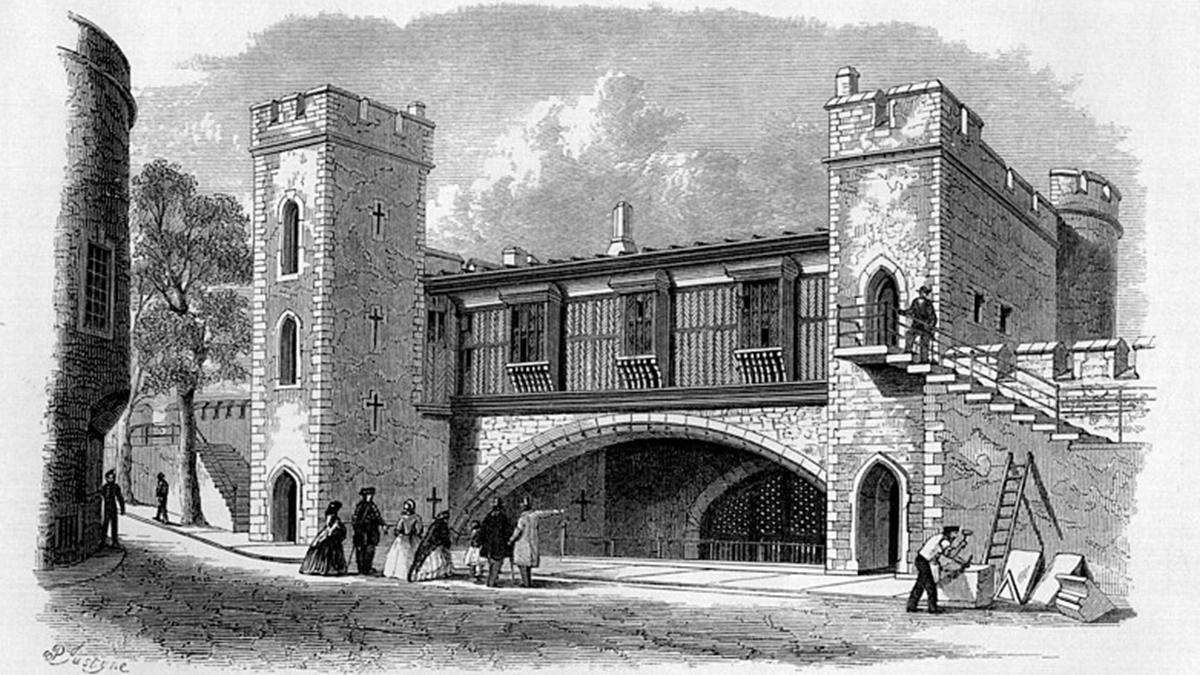Ancient London had seven gates – openings in the wall which controlled who entered and exited – Ludgate, Newgate, Aldersgate, Cripplegate, Moorgate, Bishopsgate and Aldgate. Some housed prisons, some were places that people lived in and some had pretty gruesome reputations, places where the heads of traitors were put on display.
There’s two other famous gates both which open onto the River Thames. Billingsgate was London’s old fish market, and there’s the infamous Traitor’s Gate in the Tower of London. You wouldn’t want to be going through that one, you’d be in danger of losing your head!
Ludgate
The Church of St Martin within Ludgate is the location of our first City gate, Ludgate.

It was one of original four gates in the Roman Wall, being constructed around 190 AD, and the western most gate leading to the old River Fleet crossing and on towards Bath and the South West.
There’s a blue plaque on the left hand wall of the church to mark where the gate once stood.

Imagine what it must have been like. This church was just inside the wall and was somewhere where you could conveniently get a blessing before setting off on a journey. Do you think they’d bless birds before they migrated south for the winter?!
According to legend as recorded by the Norman-Welsh cleric Geoffrey of Monmouth, Ludgate was named after the ancient British King Lud. He was said to be the brother of King Cassivelaunus but some experts in folklore think he is a manifestation of the god Nodens.

Cassivelanus was the King who led the defence when Julius Caesar attacked Briton for the second time, nearly 2000 years ago.
Back to the gate! It’s had quite a few facelifts over the years. In 1215, it was rebuilt by anti-royalist forces during the First Barons’ War. Then again around 1450 by a man called Stephen Foster, who at one time lodged in the debtor’s prison over the gate but went on to be Lord Mayor of London.
Then once more in 1586 when it was decorated with statues of Queen Elizabeth I and King Lud and his two sons. It was demolished in the 1760s, along with other gates so they could widen the roads.

Ludgate has played its part in important historical events, in part because like all gates, one of its main purposes was to help defend the city from invaders.
In 1554, it was the final setting of Sir Thomas Wyatt’s rebellion against Queen Mary. Wyatt and his followers didn’t like the idea of Queen Mary marrying a Spanish Prince. They were worried the country would return to strict Catholicism if she got her way.

When Wyatt arrived at the gate with around 400 men, he found the gate heavily defended by Lord William Howard and the local militia, who refused entry, causing the rebels to retreat and later surrender. Many of those involved met a very sticky end.
Newgate
Our next gate is Newgate. For many years it was thought that Newgate was built after the Roman period and so was ‘new’ but archaeological evidence has shown it was of Roman origin, and dates back to when it stood over Watling Street. It’s a Roman road that starts in Kent where the Romans landed in their boats and goes through London, onto St Albans and beyond.

It used to be called Chamberlain Gate but it’s thought became known as Newgate when it began to be used instead of Ludgate after the fourth St Paul’s Cathedral was built.
From the 12th century, the gate was used as a prison for debtors and felons. Jack Cade, a rebel leader, was beheaded publicly in Newgate after his rebellion failed. The gate became part of the notorious Newgate Prison when it was extended to the south where the Central Criminal Court currently stands on Old Bailey. The gate was demolished in 1767.
Newgate Street is mostly located within the city wall.

A notable archaeological discovery here was a Roman tile inscribed with a disgruntled comment that “Austalis has been going off on his own for 13 days“.
Aldersgate
Aldersgate isn’t one of the original Roman gates, it was added later in the Roman period, replacing the old west gate in the Roman fort. The name Aldersgate was first recorded around 1000 in the form Ealdredesgate, which means a “gate associated with a man named Ealdrād”.

When James VI of Scotland came to England in 1603 to take the crowns of both England and Scotland, he entered the City at Aldersgate. Statues of the king were placed both inside and outside the gate to commemorate the occasion.

The old gate was rebuilt in 1617 to a design by Gerard Christmas.
After damage by the Great Fire of 1666, it was repaired and remained until 1761. It seems like all the gates really had been in the wars, some of them literally!

Like many of the City’s local wards, the Ward of Aldersgate is traditionally divided into Aldersgate Within and Aldersgate Without, the suffix denoting whether the part was within the wall or outside it.
Oh, and the gate also gave its name to Aldersgate Street, which runs north from the former gate towards Clerkenwell.
Cripplegate
Our next gate is Cripplegate. It no longer exists but there is a blue plaque on a building called Roman House to mark where it was.

The area around here was almost completely destroyed by bombing in the Second World War and was redeveloped in the 1970s.
The name Cripplegate might come from the Anglo Saxon word “crepel” meaning covered passageway, or from the people with disabilities who used to beg here.
Like Aldersgate, the area was divided depending on whether it fell inside or outside the City wall, so you’d have Cripplegate Within and Cripplegate Without.

Cripplegate was the northern entrance to the Roman fort, leading out to the village of Islington. It was built around AD 120 – 80 years before most of the wall was completed.
It was rebuilt during the 1490s and fortified with a portcullis after Charles II became king in 1660.
It was eventually demolished in 1760.

Moorgate
Moorgate is one of the smallest gates and not an original Roman gate, but more likely a postern or side entrance in Roman times, it only became a formal gate in 1415 when a new grand gate was constructed.

Moorgate takes its name from Moorfields, a marshy area fed by the River Walbrook just outside the city walls where Finsbury Circus and Finsbury Square are now situated. The Walbrook is now covered over by roads and buildings and it’s one of London’s lost rivers.
Like other gates, it’s had its share of ups and downs! The gate was enlarged in 1472 and again in 1511, and then reputedly damaged in the Great Fire of London in 1666, although some say the fire never actually made it this far and was just blamed to fund further improvements, including pedestrian arches and an extra high main gate to allow soldiers marching through to hold their pikes straight!

It was demolished in 1762, with its stones sold for the whopping sum of £166 to the City of London Corporation to support the newly widened centre arch of the London Bridge.
Bishopsgate
By the Church of St Botolph Bishopsgate is the location of Bishopsgate named after the 7th century Bishop Erkenwald, son of King Offa. There’s no plaque to mark the site of the actual gate but there’s a bishop’s mitre on the wall at 105 Bishopsgate.

The original gate was adorned with the effigies of two bishops, probably Bishop Erkenwald and Bishop William, with effigies also of King Alfred and Alred, Earl of Mercia.
The road that would have gone through the gate is very old, it’s Ermine Street, the famous Roman road that goes north, all the way to Lincoln and York. Ermine Street sounds very grand although most people know it as the less grand sounding A10! It’s existed since the 1st century AD, while the wall and gate weren’t built until the 2nd century.
Bishopsgate was one of the eastern gates in the wall, and it played its part in a famous war. It was 1471, the War of the Roses and the gate was set on fire. The attackers came close to capturing nearby Aldgate and with it, the city. They were repelled with heavy losses and chased back to Bow Bridge and Blackwall.

The Bishop’s Gate was rebuilt by the Hansa merchants from Central and Northern Europe in exchange for steelyard privileges. The gate was rebuilt again in 1735 but demolished, like the other gates, in the 1760s.
Aldgate
Our next gate is Aldgate. You will find a blue plaque on the wall of 89 Aldgate. There’s been numerous thoughts on that from “Old Gate” or “Ale Gate” after a nearby pub or maybe “All Gate” meaning the gate was free to all.

In his Survey of London, John Stow wrote that Aldgate “hath had two pair of gates, though now but one; the hooks remaineth yet. Also there hath been two portcullisses; the one of them remaineth, the other wanteth, but the place of letting down is manifest”.
This gate guarded the important Roman road that led to Essex and Colchester, the original capital of Roman Britain, known then as Camulodunum.
Like the other gates, it was rebuilt several times, the final being in 1609 “in a more classical and less functional style” and was finally removed in 1761.

To make some money, the city came up with an idea to rent out space above the gates and they were keenly sought after due to their locations. The Father of English Literature, poet Geoffrey Chaucer lived here between 1374 and 1386 when he was a customs official. He even wrote some of his poems here!

It would have been more functional than comfortable. They were designed after all for military use, and were described as “cramped, cold, rudimentary and ill lit, even at midday”.
People were keen to rent the apartments, and we can understand why. In their day they would have been very grand to look at from the outside even if not on the inside!
Traitor’s Gate
Traitor’s Gate is at Tower of London…
Through this gate, condemned traitors were brought into the Tower for imprisonment and execution. Sir Thomas More and Queen Anne Boleyn were amongst the more famous names to have passed through this gate.

Prisoners were brought by barge along the Thames, passing under London Bridge where heads of executed prisoners were often displayed on spikes.
It wasn’t JUST for prisoners, the gate was originally built by Edward I to provide a water entrance to the Tower and was simply called Water Gate.

Billingsgate
Our final gate is Billingsgate. There’s no plaque for Billingsgate landing or the lost church of St Botolph Billingsgate but at least there is a street sign for Old Billingsgate Walk. It’s thought to be named after someone called Billing, although there is a myth that says it was named after a mythical British King.

Although not originally famous for fish, historian John Stow records that Billingsgate Market was a general market for corn, coal, iron, wine, salt, pottery, fish and miscellaneous goods until the 16th century, when neighbouring streets became a specialist fish market.

By the late 16th century, most merchant vessels had become too large to pass under London Bridge, and so Billingsgate, with its deeply recessed harbour, replaced Queenhithe as the more important landing place in the city. Billingsgate Market operated until 1982 when it was relocated to Canary Wharf.
Add a commentLondon’s History
London has a rich and full history that we can't wait to tell you all about! From The Romans of Londinium to the Tudors of London, it's all here.
More From London’s History






